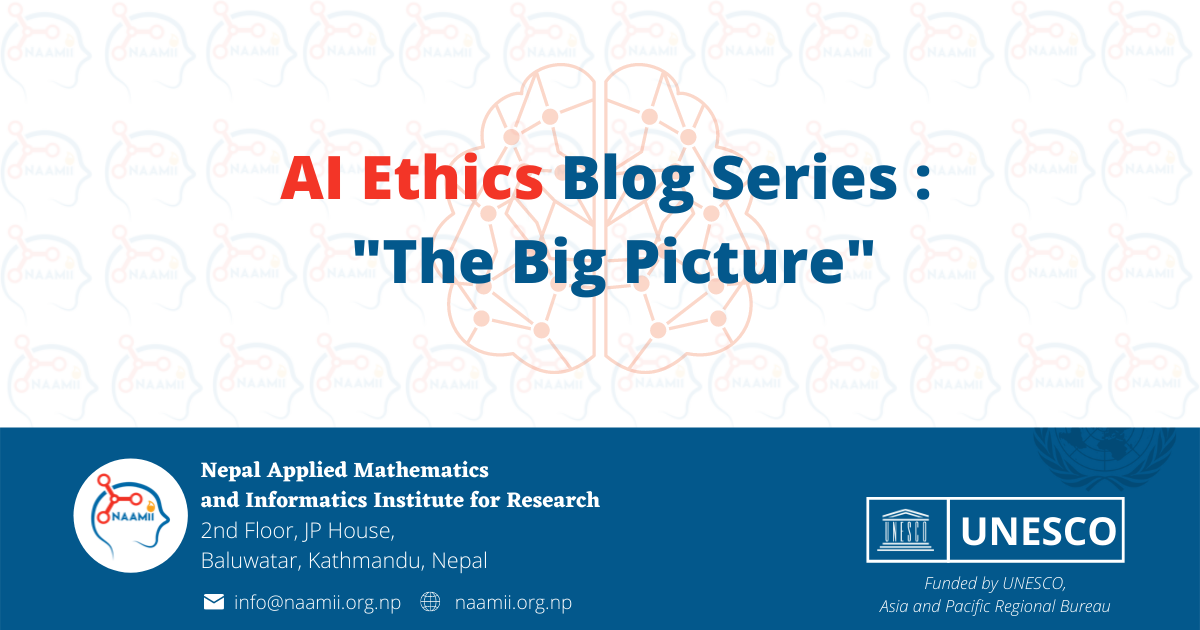
AI Ethics Blog Series : The Big Picture
- Post by: Naamii
- February 3, 2022
- No Comment
The term “Artificial Intelligence” is a broad umbrella, referring to a variety of techniques applied to a range of tasks. In popular imagination, it often compares to computers achieving general consciousness and intelligence. In practice, AI technologies in use and production today are designed to perform well on a narrowly defined task. For example, AI may be trained to detect faces in images, automated translation between languages, recommend advertisement, etc. Most of these tasks are narrowly defined and the algorithms are trained and tested with historical datasets. Recent research has also shown several limitations when these algorithms have been released in public. Data driven AI algorithms often encode existing inequalities and discriminate against marginalized groups[1] [2]. AI systems have also led to increased polarization, surveillance, misinformation, and eroded democratic norms[3] [4] [5]. Research has shown that these problems and harms can be highly contextual depending on problem domain, dataset and communities where algorithms are deployed.
An ethical framework for AI (AI ethics in short) is a way of formalizing the implications and impacts of AI algorithms. AI Ethics work can take different forms: building AI technology to solve ethical problems, building new technology in an ethical way, highlighting problems and ethical issues with existing AI technologies, advocating for better policies, and many more. However, ‘what is ethical’ is not universally agreed upon. In the global context, there have been research projects as well as national and international guidelines for responsible use of AI[6][7]. Research shows a global convergence around five ethical principles – “transparency, justice and fairness, non-maleficence, responsibility and privacy”[8]. However, how these principles are interpreted and practiced is highly contextual and depends on problem domain, application, and cultural contexts.
To the best of our knowledge, there is no public information on how AI practitioners approach ethical questions regarding AI in Nepal. In a highly unequal society such as Nepal, datasets are more likely to be biased. If we are not careful, AI technology can propagate these biases and cause harm to marginalized and vulnerable groups. The AI industry and community in Nepal is also predominantly male, urban, upper caste and well-educated and thus less aware of lived experiences of vulnerable and marginalized communities.
With the AI Ethics in Nepal project and the AI and Society research group, NAAMII is interested in contextualizing issues of AI ethics into the diverse and resource constrained context of Nepal and providing resources to stakeholders. In these series of blog posts, we will attempt to do so by sharing articles on
- AI Ethics Principles and Resources
- Contextualized research summary on harms, opportunities, and ethical design of AI
- Updates from AI ethics in Nepal project
- Naamii’s research on AI and Society
References:
[1] Sarah Myers West, Meredith Whittaker, and Kate Crawford. Discriminating Systems: Gender, Race, and Power in AI. AI Now Institute. Retrieved from https://ainowinstitute.org/discriminatingsystems.pdf
[2] Noble, Safiya Umoja. Algorithms of oppression. New York University Press, 2018.
[3] Brkan, Maja. “Artificial intelligence and democracy: The impact of disinformation, social bots and political targeting.” Delphi 2 (2019): 66.
[4] Hajli, Nick, et al. “Social Bots and the Spread of Disinformation in Social Media: The Challenges of Artificial Intelligence.” British Journal of Management (2021).
[5] Feldstein, Steven. “The road to digital unfreedom: How artificial intelligence is reshaping repression.” Journal of Democracy 30.1 (2019): 40-52.
[6] Rakova, Bogdana, et al. “Where responsible AI meets reality: Practitioner perspectives on enablers for shifting organizational practices.” Proceedings of the ACM on Human-Computer Interaction 5.CSCW1 (2021): 1-23. https://arxiv.org/pdf/2006.12358.pdf
[7] Global AI Strategy Landscape https://www.holoniq.com/wp-content/uploads/2020/02/HolonIQ-2020-AI-Strategy-Landscape.pdf
[8] Global AI Strategy Landscape https://www.holoniq.com/wp-content/uploads/2020/02/HolonIQ-2020-AI-Strategy-Landscape.pdf